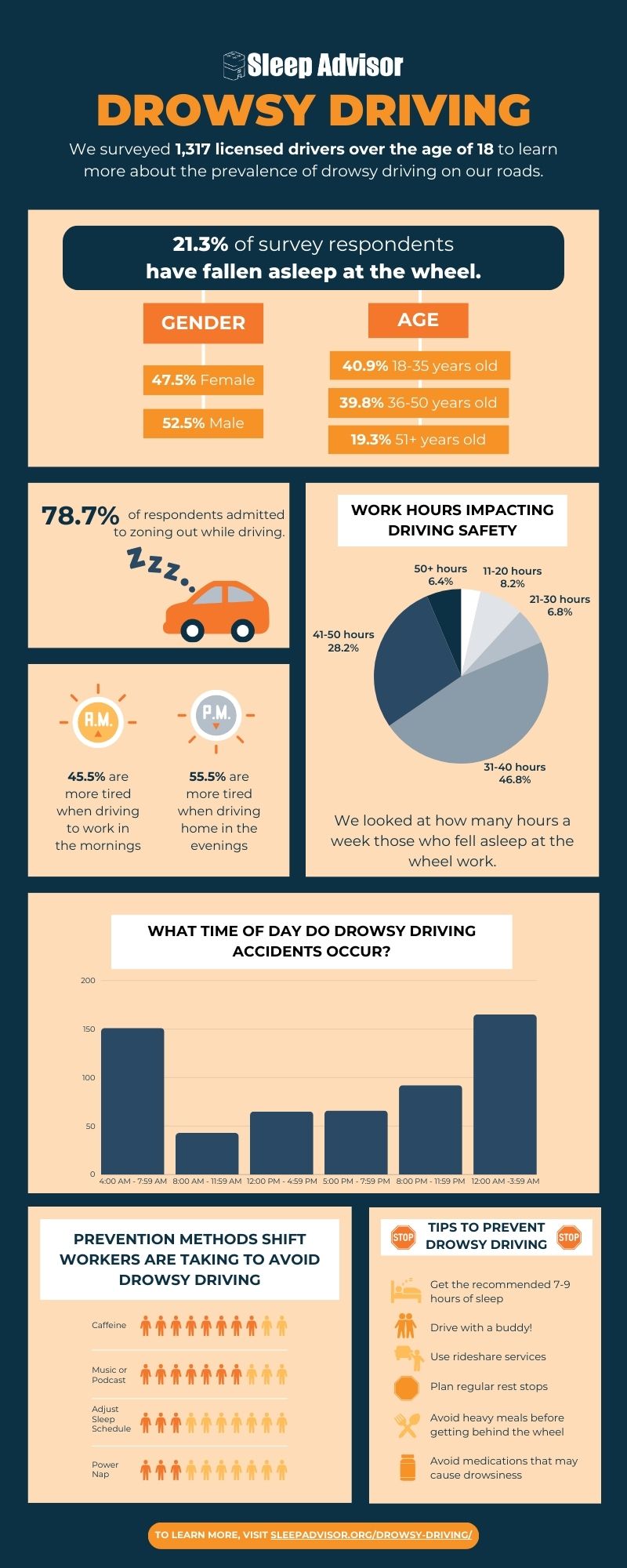If you often feel too tired to drive, you’re not alone. Drowsy driving is a bigger problem than many people realize.
To learn more about recent statistics on drowsy driving, we surveyed 1,317 licensed drivers over 18. The results may surprise you and even have you think twice about getting behind the wheel the next time you feel sleepy.
Keep reading to learn more about what we found, along with some helpful tips for staying safe on the road.
What Is Drowsy Driving?
Drowsy driving is the dangerous act of getting in the driver’s seat when you are tired or fatigued, either due to lack of sleep, medications, shift work, alcohol, or a sleep disorder. Being drowsy can impact your ability to make good decisions, slow reaction time, and make paying attention to the road more difficult.
Drowsy Driving Facts: What We Found
- 78.7% of respondents zone out while driving
- 70.1% have witnessed or been in a drowsy driving accident
- 70.1% of the accidents reported by our survey respondents occurred between 8:00 PM and 7:59 AM
- 21.3% of respondents have fallen asleep at the wheel
In our survey, as many as 78.7 percent of people reported zoning out while driving. Of those 78.7 percent, nearly 71 percent zoned out occasionally. However, the number of people who zoned out frequently or always was significantly less, at 6.9 percent and 0.9 percent, respectively.
The number of people who actually fell asleep at the wheel was 21.3 percent. More men reported falling asleep while driving than women, though the difference was only a 5 percent increase.
The variance among age groups was even smaller; the number of people between the ages of 18 and 35 sleeping at the wheel was just slightly higher than those aged 36 to 50. The number of people who fell asleep at the wheel dropped by 20 percent after age 51.
Work also affected whether people were more likely to fall asleep while driving. Interestingly, working more hours didn’t equate to a greater likelihood of falling asleep at the wheel. People who worked 31 to 40 hours a week reported the most incidents at 46.8 percent, while only 6.4 percent of people working 50 or more hours a week experienced this.
We learned that just over 70 percent of respondents either witnessed or had been involved in a drowsy driving accident. However, the difference between those who witnessed an accident versus those involved in one varied greatly, with 64.8 percent reporting witnessing an accident and 5.3 percent reporting being involved in one.

Who Most Often Falls Asleep While Driving?
Shift Workers
Circadian disruptions caused by rotating shift work can be a factor in drowsy driving. According to our survey, 21.7 percent of people admitted to falling asleep at the wheel are shift workers.
Sleep-Deprived Individuals
There are many reasons why people may experience sleep deprivation, and one of those causes can be sleep disorders like insomnia or sleep apnea. Among the respondents falling asleep at the wheel, 17.1 percent had been diagnosed with sleep apnea.
Nighttime Drivers
Many of these crashes can occur during nighttime hours. We learned that 70.1 percent of the accidents reported in our survey had occurred between 8:00 p.m. and 7:59 a.m., with 28.4 percent occurring between Midnight and 3:59 a.m.
Commuters
People who commute to work may also miss out on sleep to be on the road early enough to arrive at work on time. However, the time of day when people felt sleepy during their commute varied among respondents. More than half of people reported feeling more tired while driving home in the evening at 55.5 percent. This was compared to 45.5 percent of people who felt more tired while driving to work in the morning.
Signs You’re Too Tired to Drive
Many people are so used to being tired all of the time that they may not even notice the signs of fatigue. However, considering the risk of an accident can increase while driving drowsy, it’s important to pay attention to any warning signs that you may be too tired to get behind the wheel.
Need Coffee
Caffeine blocks adenosine receptors1 in the brain, temporarily tricking us into thinking we are rested and alert. If you are so fatigued that you cannot stay awake without drinking coffee, you should probably not be driving.
As many as 78.4 percent of survey respondents admitted to resorting to caffeine as a method of preventing drowsy driving. Among shift workers, 78.5 percent used caffeine to help keep them awake while driving.
Microsleeps
Some people may experience “microsleeps,” which are brief, involuntary periods of inattention lasting only a few seconds at a time. While these episodes may be as short as five seconds, the distance could be over half a mile when driving at highway speed.
Cognitive Impairment
A loss in the ability to hold your attention and focus is a sign of impaired cognitive performance. According to research, sleep loss and cognitive impairment account for 20% of motor vehicle accidents.
How to Stay Safe on the Road – Tips to Avoid Drowsy Driving
Before a Trip
Get Enough Sleep
You might be tempted to wake up early to get a head start on a long trip or drive through the night to avoid traffic. However, doing either of these could increase your risk of driving while tired. Instead, always start a trip well-rested so you can give your full attention to the task of driving. According to the American Academy of Sleep Medicine, adults should get at least seven hours2 of sleep a night.
Other tips for helping boost your sleep include practicing good sleep hygiene and investing in a great mattress.
Verify Any Medication Side Effects
If you take any prescription or over-the-counter medications, confirm whether drowsiness is a potential side effect. If you’re unsure, you can ask a pharmacist. Avoid driving when you start taking any medications that could induce drowsiness to judge your susceptibility to its effects. If you find it makes you overly drowsy, speak to your doctor about alternatives and aids to help so you can keep driving safely.
A Note from Dr. Raj Dasgupta on Popular Medications That May Unknowingly Cause Drowsiness
“Several medications, including antihistamines (Benadryl), anti-anxiety medications (Valium, Xanax and Ativan), muscle relaxants (Flexeril), opioids, sleep aids (Ambien, Sonata and Lunesta), and even certain blood pressure medications, can cause drowsiness as a common side effect. It’s very important to be aware of these, read your medication labels, and talk to your doctor to avoid driving while experiencing medication-induced drowsiness.”
Have a Friend Join You
To help you stay awake and alert, consider carpooling to work or asking a friend to accompany you on long trips. Having someone to talk to can help keep you focused and awake.
Plan Regular Resting Stops
You should feel encouraged to take breaks while you are driving, either to have something to eat or to take a quick nap. Even the most alert drivers should pull over for a break every couple of hours. Our survey found that 47.4 percent of respondents take frequent breaks from driving.
While On the Road
Call a Cab or Rideshare
If you are already on the road and find yourself nodding off, don’t try to stick it out and finish the drive. Instead, leave your vehicle in a secure space and call a cab, Lyft, or Uber to get where you need to go. Of those surveyed, just over 16 percent carpooled or used rideshare services to prevent drowsy driving.
Try a Coffee Nap
One trick to consider is a coffee nap. As mentioned, caffeine blocks adenosine receptors, so we feel more alert.1 However, the effects of caffeine can take roughly 15 minutes3 to kick in. Therefore, some people will drink coffee and nap for 15 minutes. Then, when they wake up, they can feel more alert from the nap and the caffeine.
Learn more: Coffee Naps
Avoid Heavy Meals
You’re probably aware of how tired you feel after a large meal. For that reason, eating a large meal before hitting the road is a bad idea. Instead, eat a light meal to curb your appetite and have small, healthy snacks on hand to help keep you alert on your trip.
More Data on Drowsy Driving:
- According to the AAA Foundation for Traffic Safety, 328,000 accidents4 occur annually as a result of drowsy driving, and 6,400 of those accidents are fatal.
- A 2019 American Academy of Sleep Medicine5 survey of 2,003 U.S. adults discovered that 45 percent have struggled to stay awake while driving.
- The annual cost of drowsy driving to society is estimated to be as high as 109 billion dollars annually, not including property damage.4
- The AAA Foundation for Traffic Safety found that missing out on just a couple of hours of sleep can double your crash risk while missing three to four hours increases the risk by 400 percent6.
- According to the National Safety Council (NSC), going more than 20 hours without sleep is equivalent to having the U.S. legal limit of a blood-alcohol concentration of 0.08 percent.4
A Note from Dr. Raj Dasgupta
As a general rule to demonstrate the association of between the effects of sleep deprivation and blood alcohol level. It is thought that: 17 hours sustained wakefulness produces performance impairment = 0.05% BAC
- legal limit in CA is 0.08%
- 24 hours of sustained wakefulness = 0.10% BAC
- People with mild to moderate untreated sleep apnea performed worse than those with a 0.06% BAC
- On 4 hours sleep, 1 beer can have the impact of a six-pack
Data from the National Highway Traffic Safety Association (NHTSA) on Drowsy Driving
- The NHTSA7 estimates that drowsy driving was responsible for 91,000 crashes, 50,000 injuries, and nearly 800 deaths in 2017. In 2021, the NHTSA reported 684 deaths due to crashes related to drowsy driving.
- Men are 5 times more likely8 than women to be involved in fatigue-related accidents.
- In 82 percent of drowsy driving crashes, the driver was alone in the vehicle.8
- Those between the ages of 16-29 are at the greatest risk, with two-thirds of these accidents occurring among drivers under the age of 30.8
Conclusion
When it comes to avoiding drowsy driving, prevention is key. Almost all causes of fatigue-related accidents could have been prevented with behavior choices.
Sometimes fatigue is inevitable – your child is sick, an assignment is due, or a health condition prevents you from getting adequate rest. While we can’t always prevent being tired, we can choose not to put others at risk. Be aware of the signs of fatigue, and follow our tips for keeping you and everyone else on the road safe.

Jill Zwarensteyn
Editor
About Author
Jill Zwarensteyn is the Editor for Sleep Advisor and a Certified Sleep Science Coach. She is enthusiastic about providing helpful and engaging information on all things sleep and wellness.
Combination Sleeper
Education & Credentials
- Certified Sleep Science Coach
References:
- Franziska Reichert, Carolin., Deboer, Tom., Landolt, Hans-Peter. “Adenosine, caffeine, and sleep–wake regulation: state of the science and perspectives”. Journal of Sleep Research. 2022.
- “Sleep FAQs”. American Academy of Sleep Medicine. Webpage accessed February 29, 2024.
- “How To Quit Caffeine Without a Headache”. Cleveland Clinic. 2023.
- “Drivers are Falling Asleep Behind the Wheel”. National Safety Council. Webpage accessed February 29, 2024.
- “Too many Americans admit to driving while drowsy”. American Academy of Sleep Medicine. 2019.
- “Prevalence of Drowsy Driving Crashes: Estimates from a Large-Scale Naturalistic Driving Study”. AAA Foundation for Traffic Safety. 2018.
- “Drowsy Driving”. National Highway Traffic Safety Association. Webpage accessed February 29, 2024.
- “Drowsy Driving and Automobile Crashes”. National Highway Traffic Safety Association. Webpage accessed February 29, 2024.